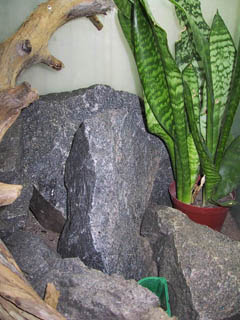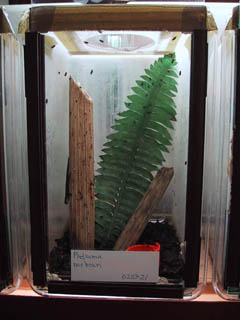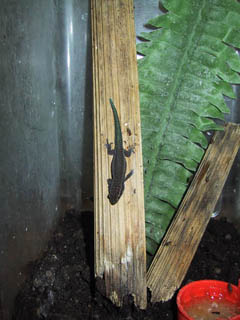 |
|
|
|
Terrariet.
2000, Nr.5,(3-12). Daggeckos
av släktet Phelsuma.
Terrariet. 2001, Nr.6,(3-9).
Phelsuma borbonica gruppen.
Terrariet.
Bevarandeprojekt. P.klemmeri.
IG-Phelsuma.
Captive
care of Phelsuma rosagularis.
IG-Phelsuma. 2002, Nr.41,(21-24). Captive care of Phelsuma
barbouri.
IG-Phelsuma.
Cloosed studbookproject. P.klemmeri.
IG-Phelsuma.
2002, Nr.41,(25-27). Species 2.5. Breedingstat.
software.
Nordisk Herpetologisk Tidskrift.
Daggeckos av släktet Phelsuma.
2002, Nr.5,(130-136).
Nordisk Herpetologisk Tidskrift.
Phelsuma borbonica. Captive care.
2003, Nr.5,(152-156).
Reptilia. 2004, Nr.34,(34-38).
Phelsuma mad. boehmei.
Reptilia. 2004, Nr.36,(43-47).
Phelsuma dubia.
Reptilia. 2005,
Nr.41,(58-65).
Phelsuma borbonica subspecies.
Chit
Chat. Nr.12,(13-15)
Captive care of Phelsuma barbouri.
|
|
Captive
care and maintenance of Phelsuma barbouri
By
Magnus Forsberg
|
|
Phelsuma
barbouri ( Loveridge 1942 ) origin from the mountains Ambohimirandrana
and Mantsina, Madagascar. They only appere on high altitudes up to 2600
meter. The klimat on this altitudes is the main reasoon that this specie
are considered a bit difficult to keep and breed in captivity. The
average temperature on yearly basis is 13,9° C. The average temperature
the coldest month is 10,2°C, and the hottest month 16,1°C. The yearly
rainfall is around 1700 mm. Normally the days are hot and dry and the
nights cool and moist. On these altitudes sunshine and UV radiation is
very intensive, and this together with the almost allways windy
conditions makes important parameters for a successful captive care of
this specie.
|
|
The Terrarium
Today
I have two terrariums with Phelsuma barbouri. In one I keep 1.1 and in
the other 1.2. The terrariums messure 50X60X50 ( length, width, hight).
Exept from the interior, two things are different from all my other
Phelsuma terrariums. Normally a third part of the top is covered with
screen for ventilation.
On the terrariums for Phelsuma barbouri the
whole area of the top is sreened. This to provide for as much
ventilation as possible. The second thing is the lightning. Normaly I
use 1-2 full spectrum tubes with UV radiation for my Phelsumas as only
light and heatsourse. For P.barbouri I use three tubes, and also one
halogenspot. The tubes are on for 14 hours between mars and october
|

|
|
and
are reduced to 10 hours between november and february. The halogen spot
are turns on at 11 and goes of at 14 the whole year. This gives the
animales a chance to bask and digest food better even under the cold
winter months.
Every evening the cage is sprayed to increase humidity.
The humiditylevels varies between 50-85% (day/night). The average
temperatures in the cages is during summertime 24°C and in winter 16°C.
Nightime temperatures in summer drops to 18°C, and in winther to 13°C.
Under the halogenspots temperature is 29-30°C all year. As substrate I
use 6 cm of sand that is sprayed every evening to hold humidity the
night through.
For climbing steady rocks and a few branches are used. A
Sansiveria plant is also included, mostly to give the terrarium a nicer
look. One of the branches reaches all the way to the top to give the
animales a chance to bask close to the tubes and the halogenspot. Even
if this specie normally lives on the ground in the wild, there behavior
in terrarium looks like most Phelsumas. They spend most of there time
climbing on the branches or the glasswalls. No bambustalks are used as
the animales seams to prefer hiding between the rocks instead of in
tubes.
They also very rarely use tubes for egglaying, and therfore I see
no reasoon for using them. As with all Phelsumas this specie benifits
highly from a outdoor summervacation in screened terrariums. They do
well outside in screened terrariums even if the temperature occasionally
should drop below 0°C.
|
|
Feeding
As
with all Phelsumas the diet contains of both insects and different kind
of fruitmixtures. I use crickets as base insect food, varied with
waxmoths and fruitflies. The fruit I use is mostly papaya, and to give
the animales some variation, yougurt, mango, banana and babydeserts are
used. The adults are feed twize a week with insects and once a week with
fruit. Every other feeding the fooditem is dusted with Minerall 1, that
I consider is the number one multivitaminpouder.
|
|
Breeding
and incubating the eggs
My
females normally lays there first clutch in the middle of september.
They continue to lay eggs once a month until the temperature get to hot,
normally at the end of june. Then they make a break and continues again
in september. Phelsuma barbouri is an egg-gluer, but not to the point as
for instance the Mauritius and Reunion species. My animales prefer to
lay eggs high up in the terrarium, mostly on the leaves of Sansiveria
but sometimes also on the glass walls. When the eggs are deposited on
leaves they can normally be removed without breaking them, and putten
into an incubator. When deposited on the glass walls they must be
incubated in situ. As egglaying perioud for my animales is during the
coldest months, incubating the eggs in situ automaticly means a very
long incubationperioud. As you can see in the diagram below the normal
incubationtime is 67-74 days in a incubator, but the eggs incubated in
situ took as much as 136 days to hatch. In the diagram you can see the
incubation datas for one of my females.
|
|
Phelsuma
barbouri
Female Ho 82
Data
for incubation:
Daytime temperature: 30,5°C.
Nighttime temperature: 26°C.
Relative humidity: 70-80 %.
|
| Eggs |
Date |
Hatched |
Days
of inc |
Hatchlings |
|
1 in situ |
2001-10-21 |
2002-03-06 |
136 |
1 |
|
2 |
2001-11-22 |
2002-02-04 |
74 |
1+1Ob |
|
2 |
2001-11-23 |
2002-03-01 |
67 |
2 |
|
2 |
2002-01-25 |
2002-04-02 |
67 |
2 |
|
2 |
2002-01-27 |
2002-05-07 |
69 |
2 |
|
2 |
2002-04-17 |
2002-06-27 |
71 |
2 |
|
2 |
2002-05-26 |
2002-08-05 |
71 |
21+1Ob |
|
2 |
2002-06-23 |
2002-09-02 |
71 |
2 |
|
1 |
2002-10-12 |
|
|
|
|
|
|
|
|
Based on these data, the average incubationtime for Phelsuma barbouri is
70 days. The one egg incubated in situ is not included. From a total of
15 eggs, 13 hatched and 2 was unfertilized.
|
|
Raising the hatchligs
As for all my Phelsumas I raise the hatchlings in modified so called
petboxes. The interior is minimal with barchmulch-substrate to be able to
maintain humidity, something to hide in and a pice of artificial plant for
climbing. All hatchligs are kept separately. This to prevent agressivness
and to easily monitor each animal. Hatchlings from Phelsuma barbouri
messure 3,2-3,5 cm and seams to be very delicate the first two months. Two
things seams to be very important to succesfully get them pass this
period. The first thing is as with the adults: good ventilation. This can
of course be satisfied in a terrarium, but it is much easier to make small
screened containers for each hatchling. These can be brought outside in
good wether. But what I have experienced to be even moore important is
frequent feeding. I feed my hatchlings with insects like small crickets
and fruitflies four times a week, and at all time they have access to some
kind of fruitmixture. If these two things are neglected the hatchlings
often die after two to three month without any visible reasoon. They look
healthy one day and die the other. Sometimes slight sheddingproblems are a
early sign of trouble. When cared for correctly the young Phelsuma
barbouri reach adult size in 8-9 months.
|


|
|
|
Literatur:
Hallmann,G.,Krüger & G.Trautmann
( 1997)
Faszinierende Taggeckos.
( Natur und Tier Verlag )
|
|
|
Captive
care and maintenance of Phelsuma klemmeri
By
Magnus Forsberg
|
|
General
Phelsuma klemmeri
was first described by Robert Seipp in 1991.It was named after K.Klemmer.
The
specie origin from only three small lokalitys in Northwestern
Madagascar.All three are near the coast at altitudes between 25-150
meters.It is mostly living on Bambu,but can be found also on other
trees.Just right to P.klemmeri
also P.mad.grandis,P.abbotti
checkei and P.seippi can be
found.From the area the followin klimatedatas was recorded(Sick
1979):Average yearly rainfall 2232 mm,Average temperature 25.7
deg.C,season variation 3.9 deg.C.The dry period is July to August and the
rainseason from November to mars.
|
|
Captive care
A
suitable terrarium for a pair or a group of adult animales (1.2-4) should
be at least 30x30x50.(LxWxH).To provide the animales with natural
light,both regarding amount of light and the quality of light,tubes with
an Ra of over 90 and 6500 kelvin should be used.There are a lot of
different tubes like Reptisun,Vitalight,Iguana light and similar.Important
is the abouve ratings and UV B output from the tubes.Of course they should
be put over the ventilation and not abouve glass.This it to provide the
animales with UV B that can not pass the glass.Since this is a rainforrest
specie no other heatsourses then the tubes should be used(exept for very
large vivaria).Ideal for the abouve terrarium is two tubes.As substate the
top two are pottingsoil and barkmulch.No artificial substrates should be
used,like papertowels, newspaper and similar.The reason for this is that
these small and flat animales very easily dehydrate, kept under those
premisses.Ideal temperatures are during the day 28-29 deg.C ,that is
allowed to drop to 21-22 deg.C at night.The humidity should stay between
70-85 %.With daily misting and the abouve guidelines this is easily
maintained.A diverse of plants are suitable for this kind of terrarium,but
Orchides and Bromelidaes are prefered.The bromelides gives the animales
somewhere to find water and suitable egglayingplaces.All live plants of
course helps to keep humidity at a stable level.Very important in any Phelsuma
terrarium are a lot of vertical and a few horisontal Bambutubes.These
serves a lot of purposes.They gives the animales ability to establish
territorys,provide them with hidingplaces and good egglayingspots.If a
hole is cut in one or a few of the vertical ones this will be the prefered
place to lay eggs.This makes it easy to look for eggs without disturbing
the animales to much.One or two Bambutubes should also be set horisontal
very close (5-10 cm) to the ceiling to provide the animales with a good
basking place.Getting this close to the lighttubes will also give them
sufficient amount of UV B.
|
|
Feeding
Like almost all Phelsuma species
they eat both insects and fruit.As base one to two week old crickets and
waxmoth are prefered.Care should be taken when feeding with crickets.Since
P.klemmeri is a very small Phelsuma
no crickets shoud get allowed to grow in the terrarium.All shoud be eaten
the same day as offered.An adult cricket can easily injure the
lizard.Fruiteflies are aslo suitable as a complement in the adult P.klemmeris
diet,even if they are best for the hatchlings.The prefered fruits are all
sweet fruits,but Papaya and Mango are the most popular.Feeding the
animales three times a week, with insects twice and fruit once is
enough.Once a week a high quality multivitamin supplement shoud be added
to the food.The easiest way is to mix it with the fruit.The last six years
I have used Miner-all that works great with all Phelsuma
species.
|
|
Breeding
This is despite its rarity one of the hardiest and easiest Phelsumas
to breed.They nomally get mature in 8-10 month.When the terrariums are
lightened 14 hours a day between February and November,and is decreased
between November and February to 10 hours a day, they normally lay there
first clutch in late mars or the beginning of April.Normally the females
after the first clutch will lay two eggs every 27-30 days until
november.They are non-gluers so the eggs can easily be removed and placed
into an incubator.The eggs are allmost allways laied two glued together to
oneother.Do not try to separate them.If kept in an incubator that is set
to a constant temperature of 28 deg.C ,and a relative humidity set to 75
%, the eggs will hatch after app.50 days.When kept in an inqubator with 30
deg.C during the day and 24 deg.C at night,and humidity during the day at
65 % and nightime at 80 % the eggs will hatch after 50-55 days.This seams
to give a moore even female to male ratio.One important thing with
hatching Phelsuma eggs is the
incubationsubstate.The eggs should be kept on slightly moist medium like
Vermaculite as all reptile eggs,but they should never
be placed directly on the moist substrate.Put them on a piece of plastic
or anything that separates them from the substrate.Since all Phelsuma
eggs are hard shelled,just like a chicken egg the lack the ability to
swell like most other reptile eggs.If putten directly on the moist
substrate the eggs will propably go full term,but never hatch.
|
|
Hatchlings
Rearing the hatchligs follows exacly the guidelines of the andults with a
few exceptions.They can easily be kept several together up to 6 month of
age.The base insectfood is fruitflies that should be offered two times a
week.Regarding fruitmixture I prefere to give them free acsess all days of
the week.In the fruit mixture multivitamins should be mixed three times a
week to prevent vitamin and mineral deficiency for the fast growing
neonates.
Good luck with the keeping and breeding of P.klemmeri.
Magnus Forsberg
|
|
|
|
|
Copyright
© 2002-2008. Magnus Forsberg Sweden. |



